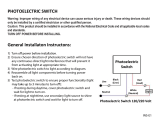
- 2 - AL802ULADAJ
Agency Listings:
• UL Listed Control Units for F
ire Protective
Signaling Systems (UL 864).
• MEA - NYC Department of Buildings Approved.
• CSFM - California State Fire Marshal Approved.
• FM - Factory Mutual Approved.
• NFPA 72 Compliant.
Input:
• Power input 120VAC 60 Hz, 5 amp.
•
Two (2) Class A, Style Z or two (2) Class B,
Style W, Y FACP inputs.
• Two (2) NC dry contact trigger inputs.
Output:
• Class 2 Rated power limited outputs.
• 24VDC @ 8 amp max total alar
m current.
• 2.5 amp max current per output.
• Separate 1.0 amp auxiliary output.
• Programmable supervised indicating circuit outputs:
Four (4) Class B, Style W, Y or Two (2) Class A,
Style Z or One (1) Class A, Style Z and Two (2) Class B,
Style W, Y (see Application Guide).
• Thermal and short circuit protection with auto reset.
Battery Backup:
• Built-in charger for sealed lead acid or gel type batteries.
•
Automatic switchover to stand-by battery when
AC Fails.
• Zero voltage drop when switching over to
battery backup.
Supervision:
• AC fail supervision (form "C" contact, 1 amp / 28VDC).
F
actory set for 30 seconds with optional 2.5 to 3 hour
delay setting (field selectable).
• Instant local AC trouble reporting relay
(form “C” contact, 1 amp / 28VDC).
• Battery presence and low battery supervision
(form "C" contact, 1 amp / 28VDC).
Visual Indicators:
• Input and output status LED indicators.
Special Features:
• 2-wire horn/strobe Sync mode allows audible
notification appliances (horns) to be silenced
while visual notification appliances (strobes)
continue to operate.
•
Temporal Code 3, Steady Mode, Input to Output
Follower Mode (maintains synchronization of
notification appliances circuit).
• Compatible with 12VDC or 24VDC fire panels.
• Output loop supervision steered to input 1 or input 2.
• Signal circuit trouble memory (helps identify
intermittent loop problems).
• Common trouble input and output.
• Ground fault detection.
Added Features:
• Unit includes power supply, red enclosure, cam lock,
and batter
y leads.
Enclosure Dimensions and Descriptions:
AL802ULADAJ
18"H x 14.5"W x 4.5"D
Product Weight:
19 lbs.
Overview:
The Altronix AL802ULADAJ is an extremely cost effective 8 amp remote power supply/battery charger. It may be con-
nected to any 12 or 24 volt Fire Alarm Control Panel (FACP). Primary applications include Notification Appliance Circuit
(NAC such as strobes and horns) expansion support to meet ADA requirements. It also provides auxiliary power to sup-
port system accessories. The unit delivers electronically regulated and filtered 24 volt power to Class B, Style W, Y or Class
A, Style Z NAC loop circuits. Additionally, a separate 1.0A auxiliary output with reset for four (4)-wire smoke detectors
is available. The 8 amp max. alarm current can be divided between the four (4) outputs for powering NAC devices. Each
output is rated at 2.5 amp max., and can be independently programmed for Steady, Temporal Code 3 or Strobe
Synchronization. All outputs may be programmed for Input to Output Follower Mode (output will follow input. i.e. March
Time Input, March Time Output). In non-alarm condition independent loop supervision for Class A, Style Z and/or Class
B, Style W, Y FACP NAC circuits is provided. In the event of a loop trouble, the FACP will be notified via the steered input
(input 1 or input 2). In addition, there are common trouble output terminals [NC, C, NO] which are used to indicate gen-
eral loop/system trouble. A common trouble input is provided for optional NC (normally closed) devices to report trouble
to the FACP. Two (2) FACP signaling outputs can be employed and directed to control supervision and power delivery to
any combination of the four (4) outputs.
Specifications:
AL802ULADAJ - NAC Power Extender
















